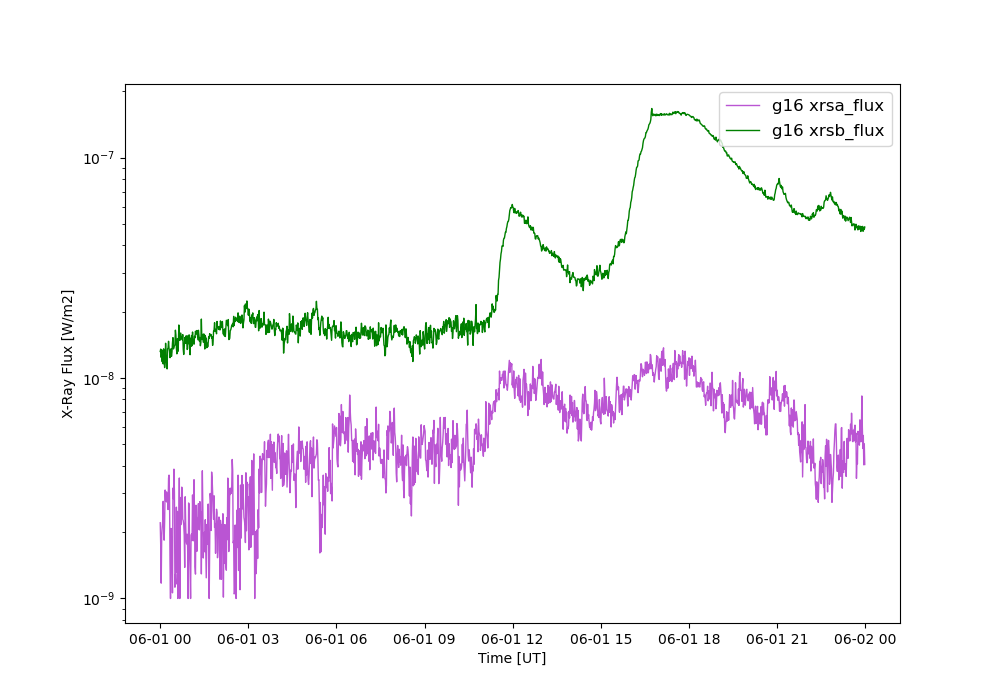Note
Go to the end to download the full example code.
Reading and plotting XRS data
- Purpose:
Python example of netcdf and plot commands for use with GOES-R EXIS files
__author__ = "jmachol"
import netCDF4 as nc
import numpy as np
import cftime
import matplotlib.pyplot as plt
from datetime import datetime
import os
import requests
num_vars = 2
make_plot = 1
Relevant data files can be downloaded here. To run this code, it may be necessary to update the filename version string (“v2-1-0”) to match available files.
Other data links and information about EXIS data can be found here
dir0 = "./"
file0 = "sci_xrsf-l2-avg1m_g16_d20200601_v2-2-0.nc"
# Download `file0` if it does not exist locally
if not os.path.exists(dir0 + file0):
with open(dir0 + file0, "wb") as f:
url_path = "https://data.ngdc.noaa.gov/platforms/solar-space-observing-satellites/goes/goes16/l2/data/xrsf-l2-avg1m_science/2020/06/"
r = requests.get(url_path + file0)
f.write(r.content)
Open netcdf file for reading data
ff = nc.Dataset(dir0 + file0)
Time conversion
datetime0 = cftime.num2pydate(ff.variables["time"][:], ff["time"].units)
print("Filename: ", file0)
print("start time in file [{}]: {}".format(ff["time"].units, ff.variables["time"][0]))
print("start and end times:", datetime0[0], datetime0[-1])
Filename: sci_xrsf-l2-avg1m_g16_d20200601_v2-2-0.nc
start time in file [seconds since 2000-01-01 12:00:00]: 644241600.0
start and end times: 2020-06-01 00:00:00 2020-06-01 23:59:00
Print some variable names and values
for ii in np.arange(num_vars):
var = list(ff.variables.keys())[ii]
val = ff.variables[var][:]
print("{}[0]: {:8g}".format(var, val[0]))
xrsa_flux[0]: 2.20548e-09
xrsa_flux_observed[0]: 6.10827e-09
Print a global attribute
platform = getattr(ff, "platform")
print("satellite: ", platform)
satellite: g16
Print all variable names
print("\nAll variable names")
print(list(ff.variables.keys()), "\n")
All variable names
['xrsa_flux', 'xrsa_flux_observed', 'xrsa_flux_electrons', 'xrsb_flux', 'xrsb_flux_observed', 'xrsb_flux_electrons', 'xrsa_flag', 'xrsb_flag', 'xrsa_num', 'xrsb_num', 'time', 'xrsa_flag_excluded', 'xrsb_flag_excluded', 'au_factor', 'corrected_current_xrsb2', 'roll_angle', 'xrsa1_flux', 'xrsa1_flux_observed', 'xrsa1_flux_electrons', 'xrsa2_flux', 'xrsa2_flux_observed', 'xrsa2_flux_electrons', 'xrsb1_flux', 'xrsb1_flux_observed', 'xrsb1_flux_electrons', 'xrsb2_flux', 'xrsb2_flux_observed', 'xrsb2_flux_electrons', 'xrs_primary_chan', 'xrsa1_flag', 'xrsa2_flag', 'xrsb1_flag', 'xrsb2_flag', 'xrsa1_num', 'xrsa2_num', 'xrsb1_num', 'xrsb2_num', 'xrsa1_flag_excluded', 'xrsa2_flag_excluded', 'xrsb1_flag_excluded', 'xrsb2_flag_excluded', 'yaw_flip_flag']
Plot 1 day of XRS data
var_name = ["xrsa_flux", "xrsb_flux"]
if make_plot:
chan_color = ["mediumorchid", "green", "darkviolet", "indigo", "b",
"darkcyan", "greenyellow", "yellow", "gold", "orange",
"orangered", "darkred"][0:num_vars]
plt.figure(0, figsize=[10, 7])
for ii in range(num_vars):
plt.plot(
datetime0[:],
ff.variables[var_name[ii]][:],
linewidth=1,
color=chan_color[ii],
label="{} {}".format(platform, var_name[ii]),
)
plt.yscale("log")
plt.legend(loc="upper right", prop={"size": 12})
plt.xlabel("Time [UT]")
plt.ylabel("X-Ray Flux [{}]".format(ff[var_name[0]].units))
plt.show()
print("Done.\n")

Done.
Total running time of the script: (0 minutes 0.436 seconds)